
Mazda MX-5 Review (2024)

Introduction
The Mazda MX-5 needs no introduction. Since we’re obliged to provide one anyway, we’ll cover the basic facts.
It is one of the longest-standing sports cars, dating back to 1989 when the first ever version was unveiled in Chicago.
It has succeeded beyond Mazda’s wildest dreams, spawning four generations and many updates to become one of the most highly regarded convertibles.
Why?
Well, the MX-5's raw simplicity has made it so popular. Mazda isn't stuck in the past - the rapid development of technology over the last 35 years has found its way into the car.
However, the MX-5's essence is in its sheer basics: affordability, fun, and its excellent driving manner. Add good reliability to all that, and when you consider how much more expensive the alternatives are, it's little wonder the MX-5 is so popular.
Now, the latest iteration of the fourth-generation car is here. But has the recipe gone stale after three-and-a-half decades – and in a world where combustion-engined sports cars are becoming increasingly rare? We are about to find out.
Select's rating score* - 4.4 / 5
At a Glance
One of the great things about the MX-5 is that, in terms of its looks, the recipe has stayed true to its roots. Despite that, it has never once looked dated.

Yes, it’s not quite as tiny as it once was, but – much like the Porsche 911 has – rather than looking like a completely different car every time Mazda redesigns it, the genesis of the original is still recognisable in the modern car.
The front features a wide, open-mouthed grille and a couple of slots for air intakes at each side, with pointed headlights, making it look sleek, sophisticated and aggressive.
The MX-5 features a smooth design at the side, with a couple of modest creases in the bodywork and flared wheel arches.
At the back, there are two circular taillights, both of which have quiff-like extensions which run around the side of the vehicle.
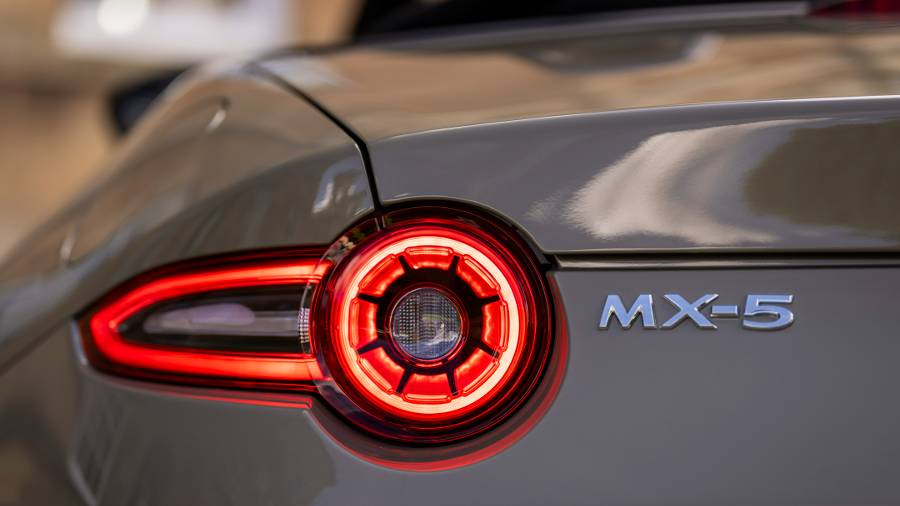
The rest of the rear features a clean design, with an indentation towards the bottom to accommodate the number plate.
Overall, the Mazda looks modern and attractive – just as it has always done.
But, as we said, there’s still more than a nod to the original design from the 80s, yet nowhere does the car look old hat.
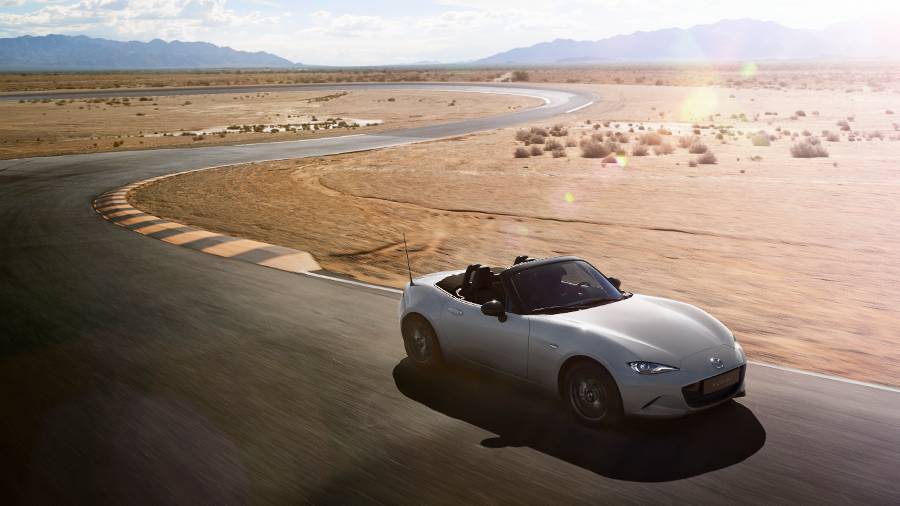
Key Features
The MX-5 comes in three new trim levels.
Entry-level Prime-Line gets 16-inch black alloys, a newly enlarged 8.8-inch infotainment touchscreen with SatNav, Apple CarPlay and Android Auto. It also has six speakers, premium black cloth and suede effect seat trim with silver stitching, electrically adjustable heated black door mirrors, an engine start/stop button, climate control, rain-sensing wipers and cruise control.
The Exclusive-Line trim includes 16-inch 'bright' alloys, black perforated leather seat trim with silver stitching, a nine-speaker Bose premium sound system, keyless entry, and dynamic stability control with track mode.
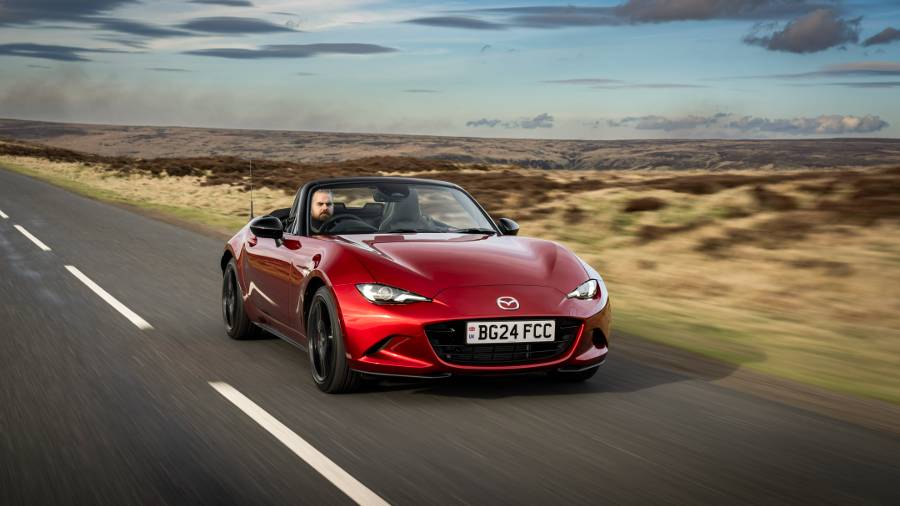
Top-of-the-range Homura trim (above) boasts 17-inch gun metallic alloys, black leather and Alcantara Recaro sports seats with contrasting grey piping, front Brembo brakes, red brake callipers, sports suspension and a new asymmetric limited-slip differential.
Two engines are available, both of which are petrol and have a six-speed manual ‘box and rear-wheel drive.
The 1.5-litre SkyActiv-G produces 132PS, while the 2.0-litre SkyActiv-G manages 184PS.
Only the mid-range Exclusive-Line gets the choice of both engines, with the entry-level Prime-Line restricted to the lower-powered unit while choosing the top model Homura obliges you to have the high-powered mill.
We are going in the middle today, so we’ve got our hands on the 1.5-litre engine in Exclusive-Line trim (below).
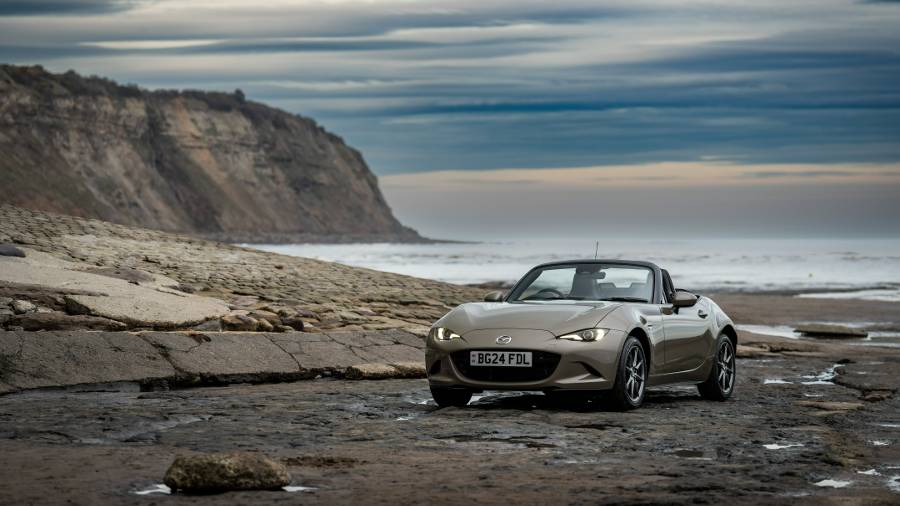
That is a good thing, as it's the one to go for. It offers several practical upgrades over the entry-level model for a not-unreasonable additional sum.
On the other hand, the Homura is considerably more expensive than our test car, partly because you're forced to have the larger engine.
It is also worth pointing out that, although we’re driving the soft-top version, there’s also an MX-5 known as the RF, which stands for ‘Retractable Fastback’.
In English, it's a hard-top convertible with a metal folding roof. The RF’s specs, trim levels, engine, and gearbox choices are the same as those of the soft-top, although the RF is more costly.
.jpg)
Performance & Drive
Although we've got a soft-top with the 1.5-litre engine, we've also driven the 2.0-litre, which feels brisk and manages 0-62mph in 6.5 seconds.
In the RF version, the additional weight of the metal roof means it takes a fraction longer – 6.8 seconds – and it's worth noting that the RF is now only available with a manual gearbox.
Of course, the MX-5 will be leased by driving enthusiasts, and while it's tempting to go with the larger powerplant, we recommend the less potent 1.5-litre unit.
The car is already light and nimble enough not to need the extra grunt of the 2.0-litre engine.
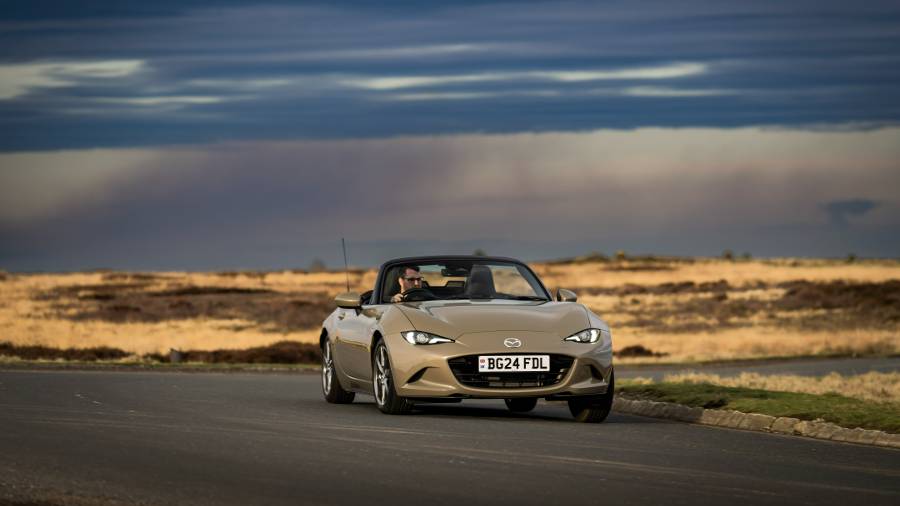
Neither engine will sound like a V8, so there's little attraction to choosing the larger unit, especially when the smaller one sounds reasonably good, considering it's only 1.5 litres.
Choosing the entry-level engine means your 0-62mph time will take around 8.3 seconds (8.7 seconds in the RF), and while that may be leisurely by sports car standards, it doesn't feel like it, especially with the roof down.
It revs nicely and sounds like it means business when pushed hard, and because of the lightness of the MX-5, it doesn't need thrashing to get decent performance out of it.
Yes, you could get far more punch from a Porsche, but when you realise that you’ll need to spend a lot more for even an entry-level Boxster, which only has a 2.0-litre engine, suddenly the MX-5 looks like a leasing bargain.
To the handling, then – what a joy the MX-5 is to take fast around a corner! It weighs around one tonne – that’s it.

By comparison, a Mercedes-Benz EQS tips the scales at about three times that, while even a comparable sports car such as the Boxster weighs around 40% more.
The result is that the MX-5 is fantastic to thread through twisty roads with agility and skill that can't be matched by any car without spending significantly more.
Because the Mazda has rear-wheel drive, you can get a cheeky kick of oversteer from the back before powering your way out of a bend.
This is aided by superb steering that weights up perfectly in the bends, giving you confidence in its accuracy as you navigate towards the next corner.
Our Exclusive-Line car gets dynamic stability control, which aids in handling.
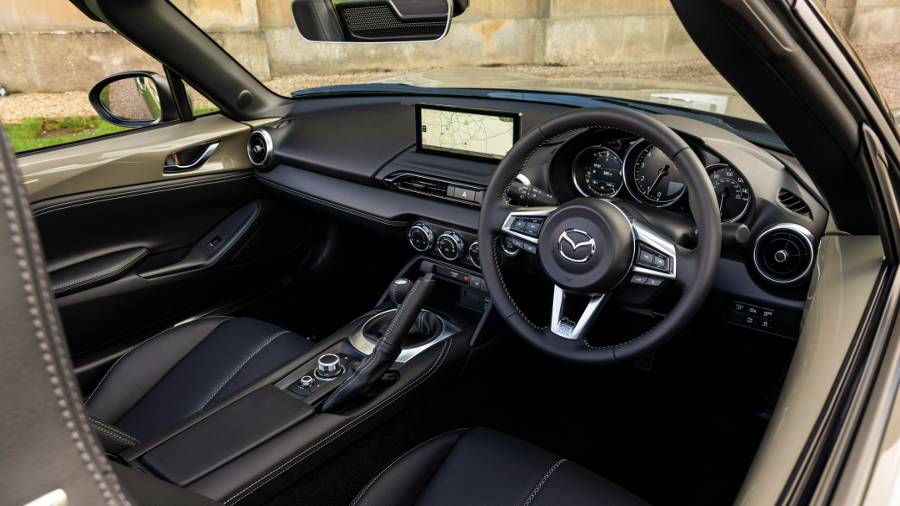
However, despite its keen driving dynamics, the MX-5 feels fairly soft and springy for a sports car with a low centre of gravity, so driving is typically comfortable.
Choose the Homura grade, and you'll also get the new asymmetric limited-slip differential to aid traction, stiffer sports suspension, and larger 17-inch alloys. Admittedly, these additions take the MX-5 up another level.
In reality, while the 1.5-litre unit is best for everyday use, if you're leasing this car for out and out hard driving days, then you may prefer the top-of-the-range spec.
Inevitably, a soft top will generate more road noise than you'd get with a car whose roof isn't designed to come off. However, it's not deafeningly loud, even at higher speeds.
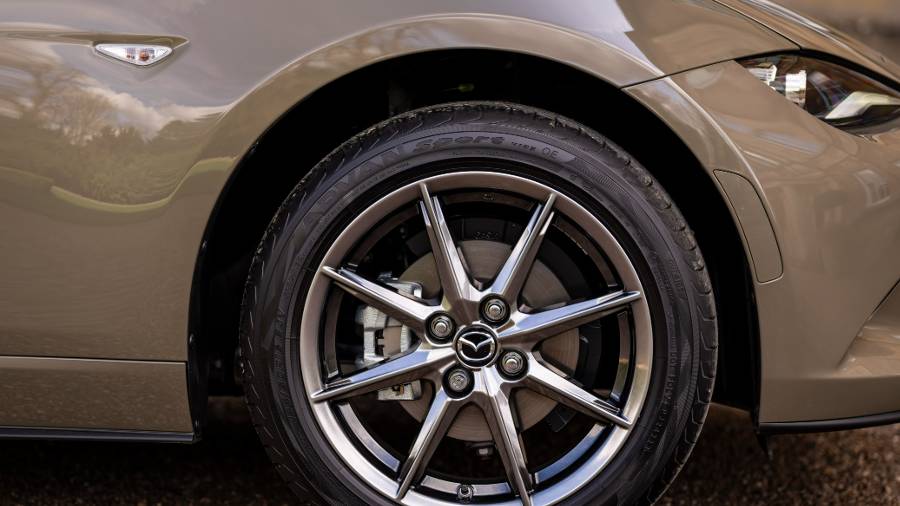
Running Costs & Emissions
Exact economy figures depend on trim; however, in the Exclusive-Line version we're testing, you'll get 44.8mpg in the lower-powered 132PS 1.5-litre engine.
That will emit 142g/km of CO2.
Upgrade to the higher-powered 184PS 2.0-litre mill, which will return 41.5mpg and 153g/km of CO2.
When you consider this is a sportscar with a decent level of performance, you can’t grumble at those figures – though, naturally, we’d expect it to be lower than this in practice once you put your foot down a bit.
We can't imagine many people will be leasing one of these as a company car – even less so given it's highly unattractive when it comes to Benefit In Kind tax.
The MX-5 has always had a good reputation for reliability, although it has performed below average compared with its competition in recent years.
Nevertheless, Mazda is considered a dependable brand, albeit not as much as some East Asian rivals, such as Kia.
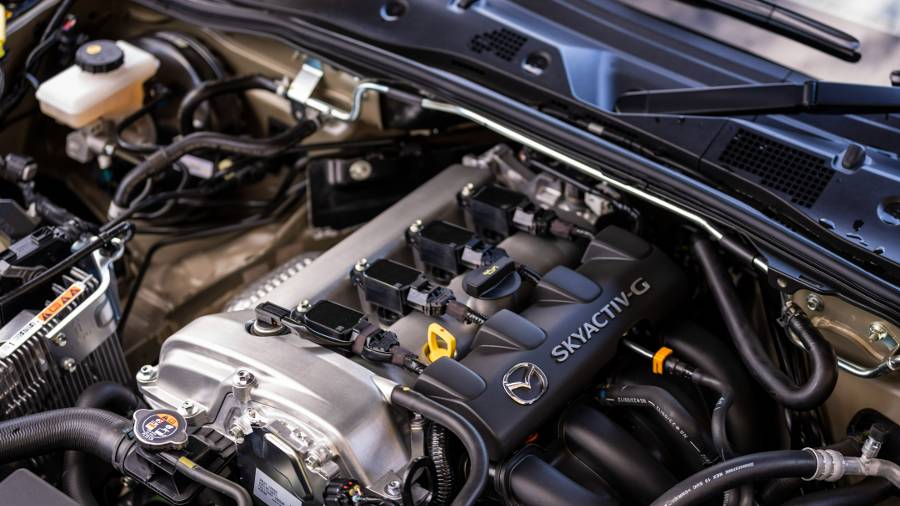
Interior & Technology
Inside, there’s a nice, premium feel to the cabin.
There is plenty of silver décor, including the spokes on the steering wheel and air conditioning controls, as well as around the air vents, rotary dials and the area surrounding the gear lever gaiter.
The gear lever is relatively short and within easy reach, adding to the sports car feel, along with the engine start/stop button.
Meanwhile, the handbrake is right next to the driver and, when engaged, points up obtusely.

Its accessible positioning likely takes inspiration from the Japanese art of drifting, though we can't claim to have tried any of that on this test drive!
Somewhat unusually, the external body colour appears inside the car towards the top of the doors, dramatically altering the feel of the interior's shading, so this is worth considering if colour combinations are important to you.
On that note, learning that bright red is the most expensive colour option won't surprise you.
We must make do with the black leather seat trim with silver stitching, as the Recaro sports seats with added Alcantara are only available on the top-of-the-range Homura trim.
The now-larger 8.8-inch infotainment touchscreen pops out from a slot in the dashboard's centre.
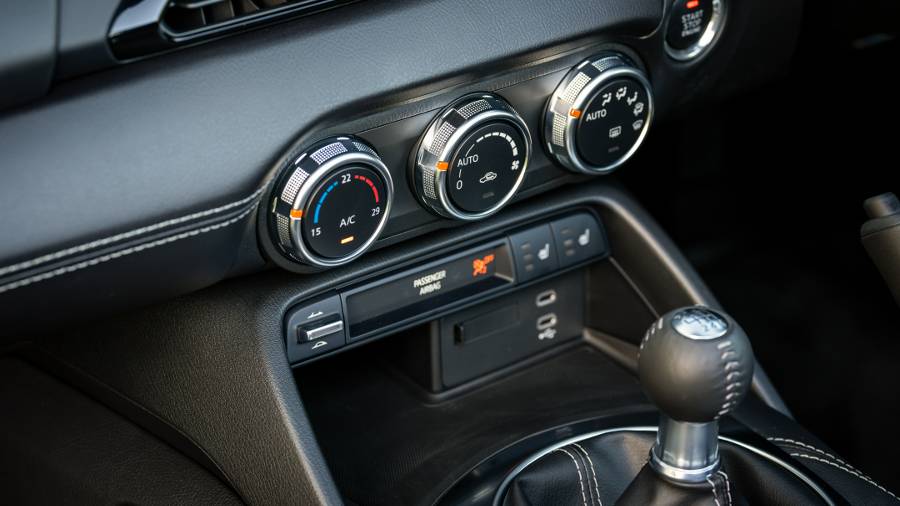
It is still on the small side by today's standards, and the system, although updated, isn’t class-leading, but it’s perfectly acceptable.
It is straightforward to use, and adding a rotary dial to control it makes things more convenient (in fact, the touchscreen functionality stops working when the car is moving). Plus, you'll find shortcut buttons by the gear lever.
The Bose sound system, standard in our Exclusive-Line test car, also sounds very nice.
Overall, the MX-5 has a nice interior, putting up a good fight among far more expensive competitors.
There are plenty of cheaper materials in the cabin, and we’d like more plush, soft-to-the-touch surfaces, but the buttons are nice to press and belie their plasticky composition.
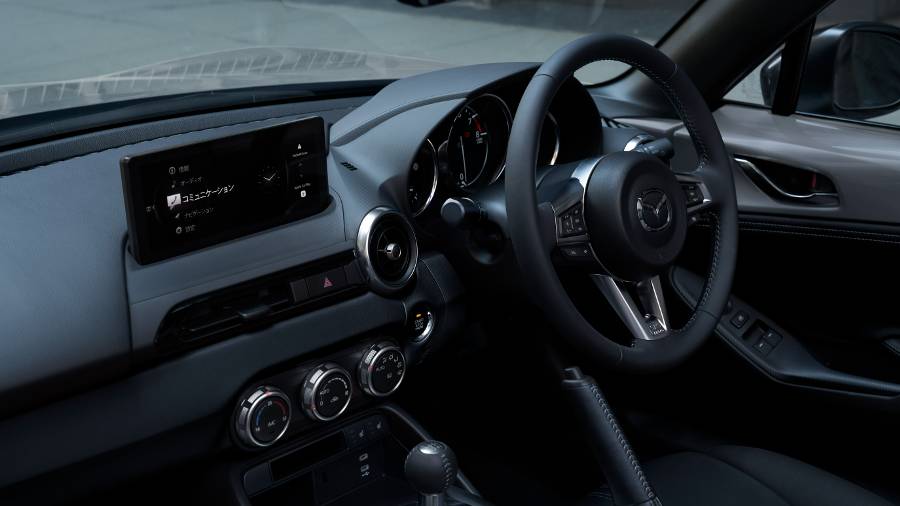
Space & Practicality
Commenting on practicality is always a challenge in sports cars because it's the one thing they're not designed for.
Alas, you won't get much in the way of space.
Firstly, it’s a two-seater, so if you’re married with kids, forget a family day out in it.
If that’s a deal-breaker, then you’ll need to look elsewhere, such as towards the BMW 4 Series, Audi A3 or A5, or the Mercedes-Benz C-Class, which are all available with rear seats – and all of which give more consideration to practicality.
Secondly, the cabin is small and snug, so you'll unlikely want to make long journeys in the MX-5 if you're tall.
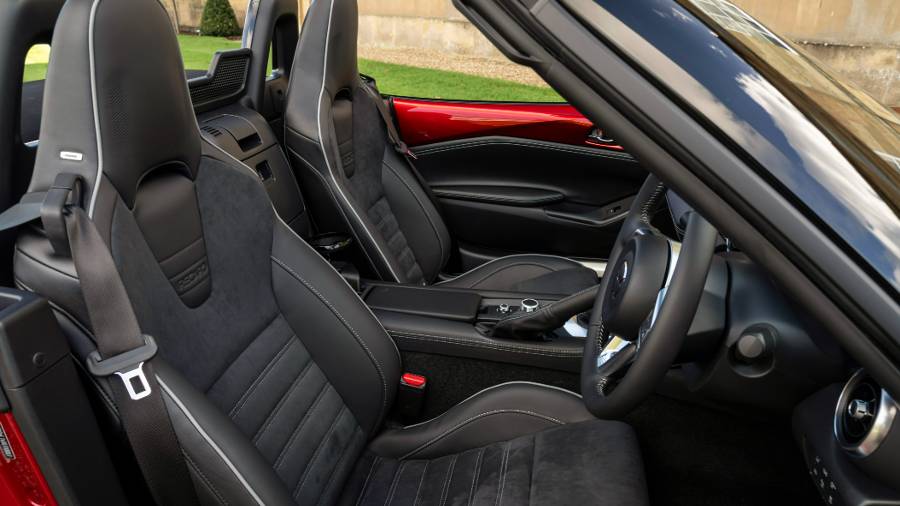
If you're a muscle-bound gym-goer, you may find it a bit cramped – and if you're on the broad side due to your lack of time at the health club, the same problem applies.
This is especially true if there are two of you, as you may find yourself rubbing shoulders with the person next to you.
You won't mind a jot if you're average size.
Your bottom hunkers into the seat, so you sit close to the road. However, the third problem is that the seat needs to be height-adjustable, although it does recline slightly via a lever on the side (neither electric seat adjustment nor lumbar adjustment is available).
For a low-to-the-ground sportscar, the MX-5 has decent visibility out of the front, with relatively thin windscreen pillars.

Your view out of the back depends on whether the roof is up or down, but the rear window is tiny, and the visibility is heavily restricted.
Our test drive was conducted in typical British weather, so we only drove with the roof up. We were relieved to get rear parking sensors in our Exclusive-Line car, but you won't get them in the Prime-Line entry-level model.
We miss out on a rear-view camera, though, as it only comes as standard on the top-of-the-range Homura trim.
There are few storage spaces inside the cabin and no door bins, though there is a semi-decently sized cubby in the centre console and two cup holders.
In terms of boot space, only 130-litres is available.
To put that into context, a BMW 2 Series – a small saloon – will get you more than three times that amount.
Direct rivals such as the BMW Z4 offer more than double the MX-5's capacity. However, being a two-seater, the rear seats do not fold down to increase the available space.
The boot's somewhat rounded shape and load lip make placing anything but a few small bags in there a squeeze.
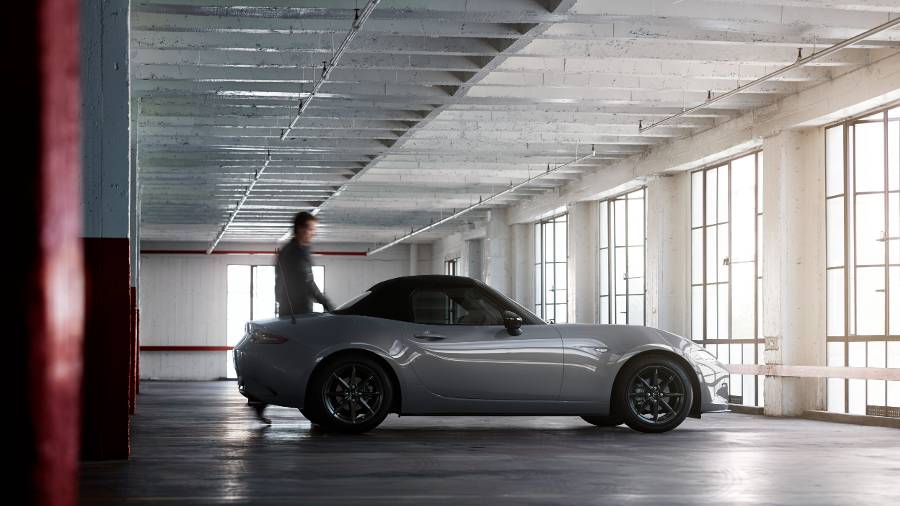
Safety
The Mazda MX-5 was put through its paces by Euro NCAP, earning a four-star rating.
That's okay for a lightweight sportscar, although the crash-testing bar has been raised since it was last tested in 2015.
Nevertheless, it earned an 84% score for adult occupants, 80% for children and 64% for safety assists.
Mazda has added more safety tech to its vehicles over the years, and all MX-5s come with driver attention alert, dynamic stability control, lane-keep assist with lane-departure warning, tyre pressure monitoring, and traffic sign recognition.
You need to upgrade to Exclusive-Line trim to get dynamic stability control. In contrast, the top-of-the-range Homura trim gets blind spot monitoring with rear cross-traffic alert and a reversing camera.
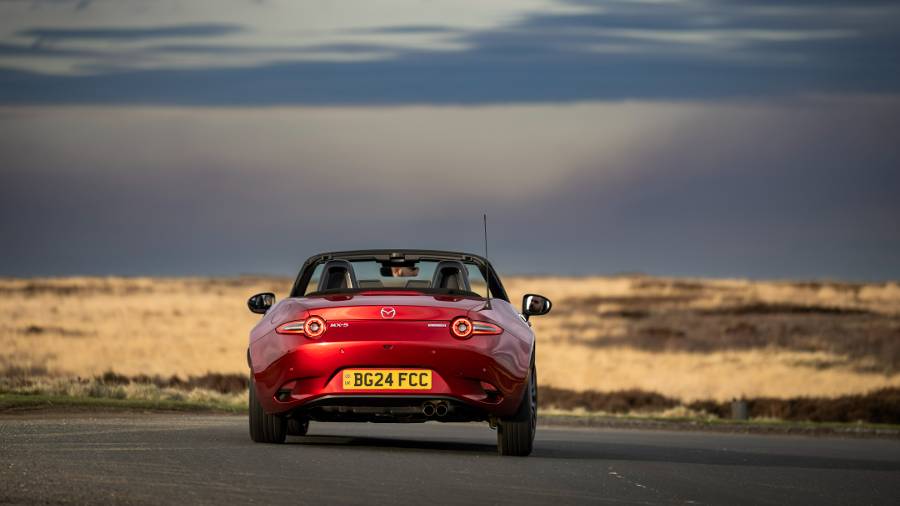
Options
Mazda offers a wide range of accessories and optional extras.
Firstly, the MX-5 comes in 'arctic white' as the default colour, but if you're happy to pay extra, grey, sand gold, dark blue, jet black, dark grey and bright red are alternatives.
In addition, there's a seemingly endless list of items you can have if you want to spend more, including reflector sets, exterior styling elements, sports exhausts, oil filler caps, and side indicator decorations.
You can even choose a coloured key fob cover, boot nets, wind blockers, phone charging cables and floor mats.
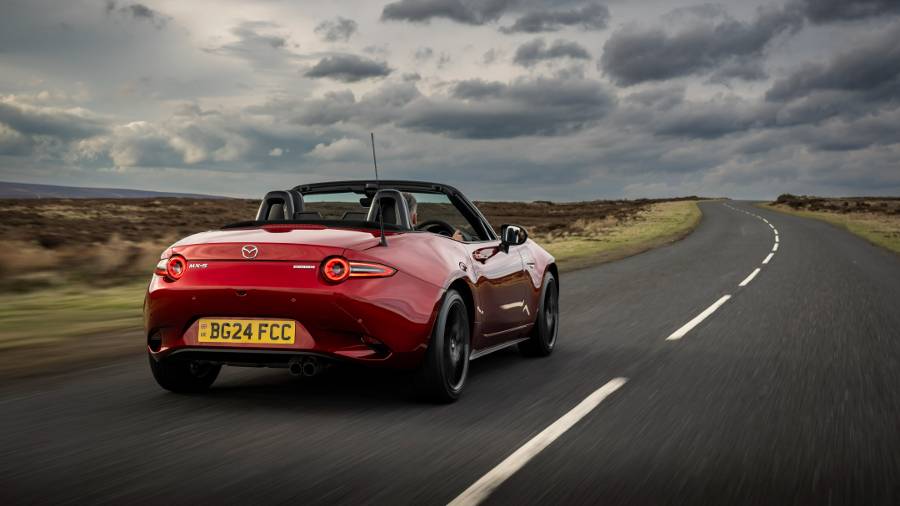
Rival Cars
The MX-5’s main rival these days is the BMW Z4. However, it’s more expensive to lease.
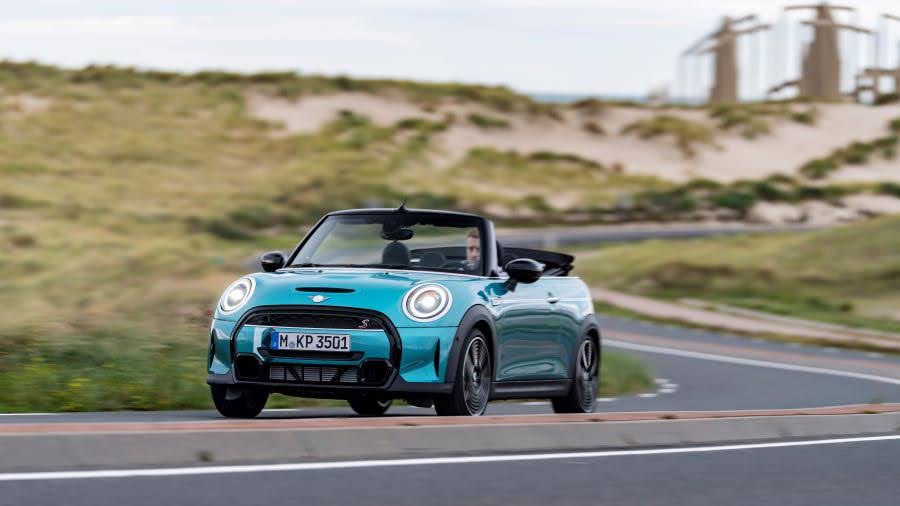
You could also try a Mini Convertible (above), or the Alpine A110, but the latter is considerably more expensive than the Porsche Boxster.
If practicality is a concern, as mentioned earlier, plenty of four-seater convertibles from the likes of Audi, BMW, and Mercedes-Benz, are available to lease.
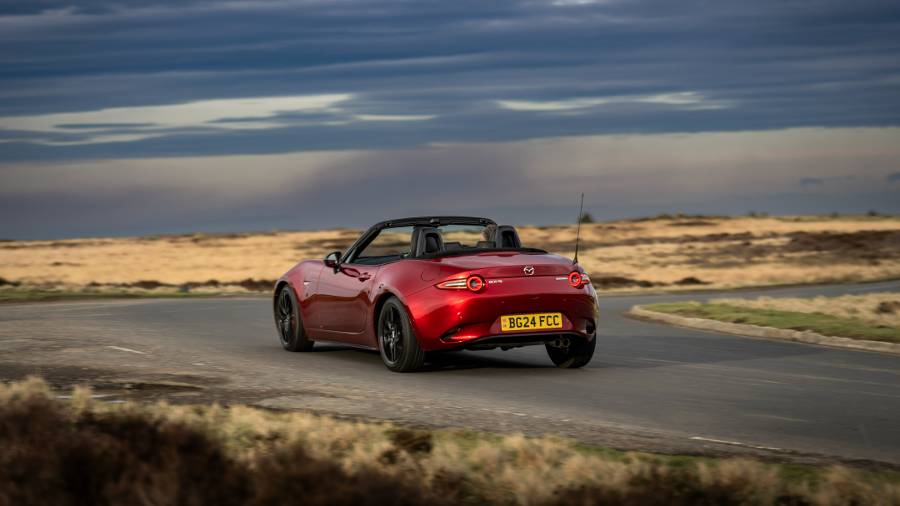
Verdict & Next Steps
Overall, the Mazda MX-5 is a superb two-seater sports car that is every bit as deserving as its acclaimed reputation suggests.
Yes, it could be more practical, and you'll likely get nowhere near the reasonably economical fuel consumption figures if you drive it the way an MX-5 is meant to be driven.
But, while it's not a high-performance car, and the engines aren't screaming 4.0-litre V8s or even six-cylinders, it matters little once you get behind the wheel.
Tidy handling, a simple manual transmission and lovely looks add to the formula that has made the MX-5 so successful over the years.
Getting a true sports car for less is impossible – and that remains the MX-5's most significant selling - or leasing - point!
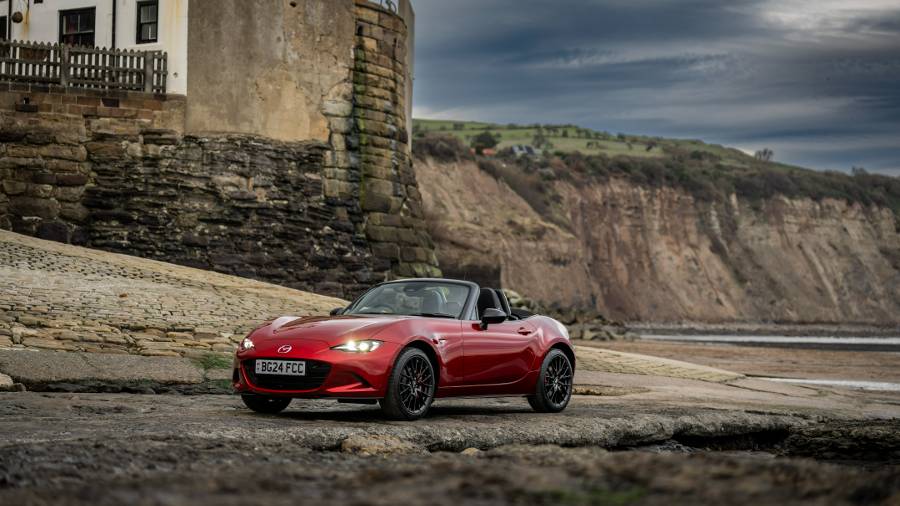
Where to next?
View latest Mazda MX-5 lease deals - from just £333 per month inc VAT**.
Call us on 0118 3048 688 or hit the green 'Enquire' button for more details.
Looking for a great leasing deal? Check out our incredible range of Special Offers and Lease Deals.
New Convertible? Read our latest Reviews and find the right model for you.
Want to know more about leasing? Take a look at our comprehensive Leasing Guides.
Interested in everything motoring? Why not catch up on all the latest Car Leasing News.
**Score based on Select’s unique meta score analysis, taking into account the UK’s top leading independent car website reviews of the Mazda MX-5.
**Correct as of 23/04/2024. Based on 9 months initial payment, 5,000 miles annually, over a 48 month lease. Initial payment equivalent to 9 monthly payments, or £2,994.30 (Plus admin fee) Ts and Cs apply. Credit is subject to status.




















